
The Zingiberales are flowering plants forming one of four orders in the commelinids clade of monocots, together with its sister order, Commelinales. The order includes 68 genera and 2,600 species. Zingiberales are a unique though morphologically diverse order that has been widely recognised as such over a long period of time. They are usually large herbaceous plants with rhizomatous root systems and lacking an aerial stem except when flowering. Flowers are usually large and showy, and the stamens are often modified (staminodes) to also form colourful petal-like structures that attract pollinators.

Zingiberaceae or the ginger family is a family of flowering plants made up of about 50 genera with a total of about 1600 known species of aromatic perennial herbs with creeping horizontal or tuberous rhizomes distributed throughout tropical Africa, Asia, and the Americas. Many of the family's species are important ornamental, spice, or medicinal plants. Ornamental genera include the shell gingers (Alpinia), Siam or summer tulip, Globba, ginger lily (Hedychium), Kaempferia, torch-ginger Etlingera elatior, Renealmia, and ginger (Zingiber). Spices include ginger (Zingiber), galangal or Thai ginger, melegueta pepper, myoga, korarima, turmeric (Curcuma), and cardamom.

Musaceae is a family of flowering plants composed of three genera with about 91 known species, placed in the order Zingiberales. The family is native to the tropics of Africa and Asia. The plants have a large herbaceous growth habit with leaves with overlapping basal sheaths that form a pseudostem making some members appear to be woody trees. In most treatments, the family has three genera, Musa, Musella and Ensete. Cultivated bananas are commercially important members of the family, and many others are grown as ornamental plants.

Myoga, myoga ginger or Japanese ginger is the species Zingiber mioga in the family Zingiberaceae. It is a deciduous herbaceous perennial native to Japan, China, and the southern part of Korea. Only its edible flower buds and flavorful shoots are used in cooking. The flower buds are finely shredded and used in Japanese cuisine as a garnish for miso soup, sunomono, and dishes such as roasted eggplant. In Korean cuisine, the flower buds are skewered alternately with pieces of meat and then are pan-fried.

Zingiber is a genus of flowering plants in the family Zingiberaceae. It is native to Southeast Asia, especially in Thailand, China, the Indian Subcontinent, and New Guinea. It contains the true gingers, plants grown the world over for their culinary value. The most well known species are Z. officinale and Z. mioga, two garden gingers.

François Gagnepain was a French botanist. The standard botanical author abbreviation Gagnep. is applied to plants described by Gagnepain.

Hedychium is a genus of flowering plants in the ginger family Zingiberaceae, native to lightly wooded habitats in Asia. There are approximately 70-80 known species, native to India, Southeast Asia, and Madagascar. Some species have become widely naturalized in other lands, and considered invasive in some places.
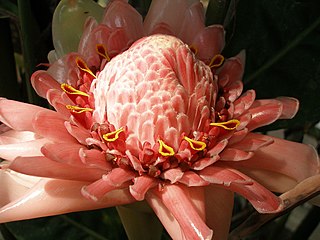
Etlingera elatior is a species of herbaceous perennial plant in the family Zingiberaceae; it is native to Indonesia, Thailand, Malaysia and New Guinea.
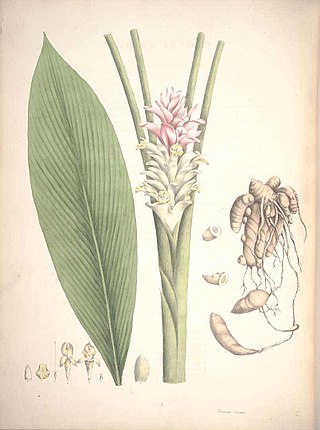
Curcuma amada, or mango ginger is a plant of the ginger family Zingiberaceae and is closely related to turmeric. The rhizomes are very similar to common ginger but lack its pungency, and instead have a raw mango flavour.

Chamagne is a commune in the Vosges department in Grand Est in northeastern France.
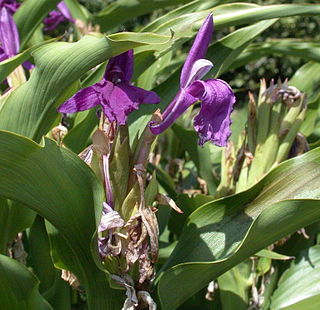
Roscoea is a genus of perennial plants of the family Zingiberaceae. While most members of the ginger family are tropical, Roscoea species are native to cooler mountainous regions of the Himalayas, China and its southern neighbours. Roscoea flowers superficially resemble orchids, although they are not related. The flowers of Roscoea have a complicated structure, in which some of the showy coloured parts are not formed by petals, but by staminodes, sterile stamens which have evolved to resemble petals. Some species are grown as ornamental plants in gardens.

Cautleya is a small genus of perennial plants of the family Zingiberaceae, found in the eastern Himalayas through to China and Vietnam. It consists of two species of high-altitude tropical and temperate plants, native to cool forest areas – an unusual habitat for members of the Zingiberaceae. They are grown as ornamental flowering plants.
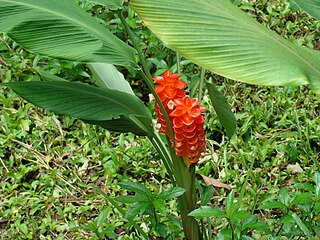
Curcuma roscoeana is a plant of the Zingiberaceae or ginger family.
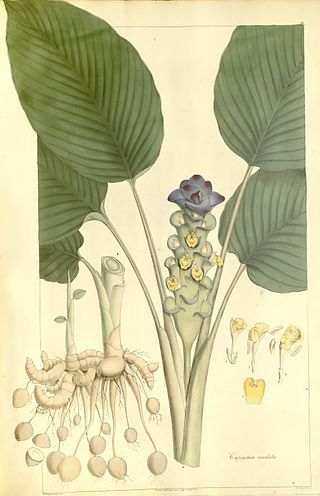
Curcuma petiolata is a plant of the Zingiberaceae or ginger family.

Wurfbainia is an Asian genus of flowering plants in the family Zingiberaceae. Species in this genus have been recorded from the Himalayas, South China, Indo-China and Western & Central Malesia. It has previously been placed as a synonym of Amomum.
Hornstedtia costata is a ginger-like plant native to Bangladesh, Assam, Bhutan, Arunachal Pradesh. Previously this species has been placed in the genera Alpinia and Amomum.
Costus curvibracteatus is a tropical rhizomatous perennial native to Costa Rica and Panama.

Alpinioideae is a subfamily of plants in the family Zingiberaceae.
Rosemary Margaret Smith (1933–2004) was a Scottish botanist and illustrator who specialized in the taxonomy of the Zingiberaceae, or ginger family. Many of the species she classified and identified as being placed into improper genera were found in Asian countries, especially in the isolated island of Borneo.
Epiamomum is a genus of plants in the family Zingiberaceae and tribe Alpinieae; all records to date are from Borneo island. Before 2018, some species were placed in the genus Amomum.
















